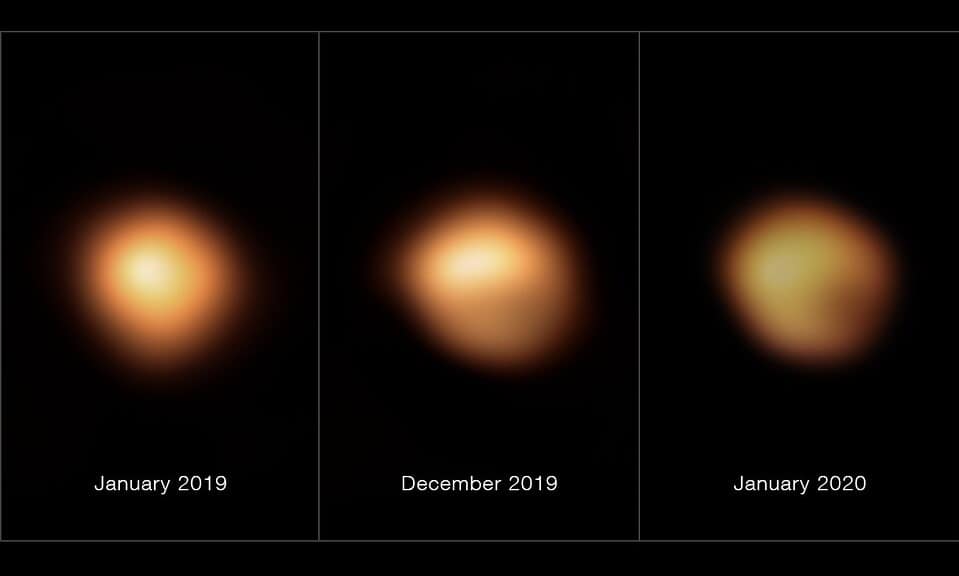The dramatic dimming of the red supergiant star Betelgeuse in 2019–20 was caused by a cold spot on the surface of the star causing a nearby gas cloud to cool and condense into obscuring dust, according to new findings.
Betelgeuse, on the shoulder of Orion, usually shines as the tenth brightest star in the sky. As a semi-regular variable star, it does fluctuate slightly as it pulsates but beginning in October 2019, Betelgeuse was seen to sharply dip in brightness, from magnitude +0.5 to an unprecedented magnitude +1.64 – three times fainter – by February 2020.
This “Great Dimming” event captivated both amateur and professional astronomers, resulting in some wild speculation that Betelgeuse was about to explode in a supernova. On the contrary, it has since returned to its regular brightness.
Images taken during the dimming by the SPHERE instrument on the Very Large Telescope in Chile were able to resolve Betelgeuse, which is about 548 light years away, as a disc. They showed that the dimming was confined to a region of Betelgeuse’s southern hemisphere. This region was ten times fainter than the rest of the star.
Two explanations
When the dimming was first observed, two main explanations emerged. One was that an orbiting dust cloud was obscuring the star and the other was that an anomalous cold patch had formed on Betelgeuse’s surface. The dust cloud explanation had been most favoured, however, the dust could not be orbiting the star, because that would cause a periodic dimming, which was not seen by SPHERE
Now an international team of astronomers, led by Miguel Montargès of the Observatoire de Paris in France and the Institute of Astronomy at KU Leuven in Belgium, argue that both explanations are correct, and connected.
“We think the rapid condensation of dust due to a cool spot caused [Betelgeuse’s] brightness to drop off so steeply,” Montargès tells Physics World.
Large convective cell
Their conclusion builds on work done in 2020, when a team led by Graham Harper of the University of Colorado, Boulder used photometry to observe light emitted by molecules of titanium oxide in the atmosphere of Betelgeuse. They found that whatever instigated the dimming did indeed manifest as a cold patch in the star’s atmosphere. Cool stars like Betelgeuse are highly convective, with convection cells the size of giant planets bubbling up to the surface and sinking again. The cool spot therefore could have been produced by an unusually large convective cell.
Also in 2020, research by Emily Levesque of the University of Washington, Seattle, and Philip Massey of Lowell Observatory in Arizona, showed that Betelgeuse’s overall temperature did not drop below 3600 K, which is too high to translate into the observed dimming. Therefore, the cool spot alone could not have resulted in a significant enough decrease in overall temperature to affect Betelgeuse’s luminosity so dramatically.
Now, Montargès’s team has linked the cool spot with the formation of dust — and connected both with the star’s cycle of variability. Previous work by a team led by Meridith Joyce, formerly of the Australian National University and now at the Space Telescope Science Institute in the US measured Betelgeuse’s primary period of variability as being 416 days (± 24 days) and confirmed that the variability is the result of the star’s natural pulsations. The onset of the dimming came 424 days after the previous minimum in the star’s brightness cycle, coinciding with the next expected minimum and implying a connection between the dimming and the 416-day-long pulsation period.
Clumps of gas
Montargès and colleagues suggest that the cool spot, brought about by the pulsations, reduced the amount of radiation incident on a gas cloud that had been emitted by the star, but which was not in orbit around it. The origin of this gas cloud is uncertain, but observations of Betelgeuse with SPHERE in March 2015 showed asymmetries in its disc, which could be clumps of gas being ejected by the star.
“Our best guess is that [the gas cloud] was ejected by a more powerful than usual convective cell on the star,” says Montargès. Aligned with the cooler spot along our line of sight, the cloud would have dropped in temperature and condensed into dust particles that obscured the star, causing even more dimming.
Has Betelgeuse’s ‘Great Dimming’ finally been explained?
Joyce agrees that a link between the period of variability, the cold spot and dust formation is probable, and that the gas cloud must have been ejected recently, rather than being in orbit around Betelgeuse. “To my knowledge, this is the first such event that has been observed and monitored so extensively, and now explained,” Joyce says.
Betelgeuse’s prominence in the night sky means that it is observed more often than any other red supergiant, but Joyce says, “I’m sure there will be great interest in other, similar red supergiants in the future”.
Montargès echoes this, pointing out that currently only a handful of red supergiant stars out of thousands that exist in our galaxy are routinely monitored. However, “The Vera Rubin Observatory will change this,” says Montargès of the 8.4-metre survey telescope in Chile that will begin scientific operations in 2022–23.
The research is described in Nature.
